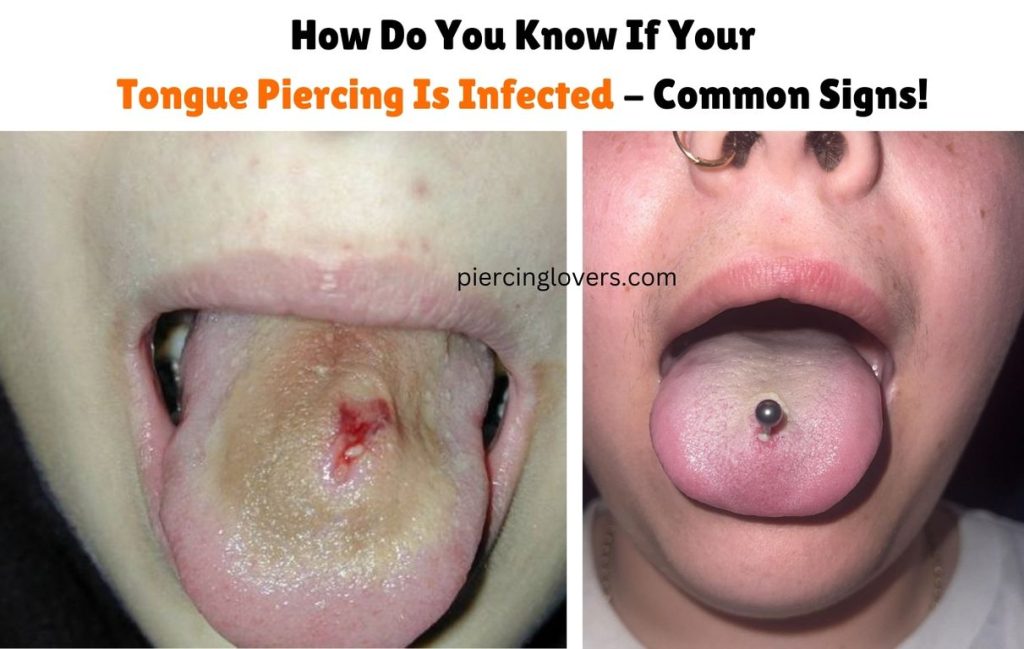Getting a tongue piercing can be an exciting way to express your style, but it also comes with its own set of responsibilities and risks. One of the most important aspects of caring for a tongue piercing is recognizing the signs of an infection early. Understanding how to spot an infection can help you take action quickly and avoid more serious complications.
Well, but how can you tell if your tongue piercing is infected? In this article will guide you through the common signs of a tongue piercing infection, how to care for your piercing, and when to seek professional help.
Understanding Tongue Piercing Infections
Before diving into the signs of an infection, it’s helpful to understand what an infection is. An infection occurs when bacteria, viruses, or fungi enter the body and start to multiply, causing symptoms like redness, swelling, and pain. For tongue piercings, the mouth is a warm and moist environment, which can sometimes make it easier for bacteria to thrive if proper hygiene isn’t maintained.
Common Signs Of Tongue Piercing Infection
- Redness and Swelling: Initially, a small amount of redness and swelling is normal after getting a tongue piercing. However, if these symptoms persist beyond the initial healing period or worsen, it might be a sign of infection. Look for a bright red color and noticeable puffiness that doesn’t seem to subside.
- Pain and Tenderness: It’s normal to feel some discomfort after getting your piercing. Yet, if the pain becomes intense, throbbing, or is accompanied by extreme tenderness around the piercing site, it could indicate an infection. Persistent pain, especially if it seems to increase over time, should be taken seriously.
- Discharge: A small amount of clear or white discharge is typical during the healing process. However, if you notice thick, yellow, or green pus coming from the piercing, it’s a sign of infection. This kind of discharge can have an unpleasant odor and may be a key indicator that something is wrong.
- Fever: A fever is not a typical response to a new piercing, but it can be a sign that an infection has spread. If you develop a fever alongside other symptoms like increased pain or swelling, it’s important to seek medical attention.
- Heat: If the area around your piercing feels warm or hot to the touch, it could be a sign of inflammation or infection. The body often reacts to infections by increasing blood flow to the affected area, which can cause this sensation.
- Difficulty Eating or Speaking: An infected tongue piercing can make it difficult to eat or speak comfortably. If you find it increasingly painful to perform these daily activities, the infection might be affecting the surrounding tissues.
- Unusual Odor: An unpleasant smell coming from your mouth or the piercing site can be a sign of an infection. This is often due to the buildup of bacteria and pus in the area.
How to Care for Your Tongue Piercing
Proper care is crucial for preventing infections and ensuring that your piercing heals well. Here are some tips how to take care of a tongue piercing and reduce the risk of infection:
- Follow Aftercare Instructions: Your piercer will provide specific aftercare instructions, including how to clean your piercing and what products to use. Be sure to follow these guidelines closely.
- Use a Saltwater Solution: Rinsing your mouth with a saltwater solution can help keep the piercing clean. Mix a teaspoon of sea salt with a cup of warm water and rinse your mouth several times a day. This helps reduce bacteria and promotes healing.
- Avoid Alcohol-Based Mouthwashes: Alcohol-based mouthwashes can be too harsh for a new piercing and may irritate the area. Instead, opt for an alcohol-free mouthwash or stick with the saltwater solution.
- Keep the Piercing Clean: Gently clean the piercing with a mild, non-alcoholic antibacterial soap and warm water. Avoid using strong chemicals or scrubbing the area too vigorously.
- Avoid Oral Contact: During the healing process, try to avoid oral contact with other people, including kissing and sharing utensils. This helps reduce the risk of introducing new bacteria to the piercing.
- Be Cautious with Food: Avoid eating spicy, acidic, or rough foods that could irritate the piercing. Stick to soft, bland foods until your piercing has fully healed.
- Change Your Jewelry Carefully: If you need to change your jewelry, make sure your hands are clean and the new jewelry is sterilized. If you’re unsure about changing the jewelry yourself, seek help from a professional piercer.
If Infected, When to Seek Professional Help For Tongue Piercing
If you notice any of the signs of infection mentioned earlier, it’s important to take action quickly. In many cases, infections can be treated with proper care and antibiotics. However, if you experience severe symptoms or if the infection doesn’t improve with at-home care, it’s crucial to seek professional medical help.
- Consult Your Piercer: If you suspect an infection, contact your piercer for advice. They can help assess the situation and provide guidance on whether you need to see a doctor.
- See a Healthcare Provider: If symptoms persist or worsen, consult a healthcare provider. They can examine your piercing, prescribe antibiotics if needed, and offer additional treatment options.
- Emergency Care: In rare cases, if you experience severe symptoms like high fever, spreading redness, or severe pain, seek emergency medical care. This can help prevent the infection from spreading further. If you want you can also learn How Much Does a Tongue Piercing Cost?
Frequently Asked Questions
Q: What are the first signs of a tongue piercing infection?
A: Initial signs include persistent redness, swelling, increased pain, and abnormal discharge. If the piercing is warm to the touch or you develop a fever, these could also indicate an infection.
Q: How can I tell if my tongue piercing is infected or just healing normally?
A: Infections often present with severe redness, swelling, pus, and prolonged pain. Normal healing involves minor redness and swelling that should gradually decrease.
Q: Is redness around the piercing a sign of infection?
A: Some redness is normal initially, but if it persists, spreads, or is accompanied by swelling, pain, or discharge, it might be a sign of infection.
Q: What kind of discharge indicates an infection in a tongue piercing?
A: Thick, yellow, green, or foul-smelling discharge is a sign of infection. Normal healing might involve clear or slightly whitish discharge.
Q: How much swelling is normal for a new tongue piercing?
A: Some swelling is normal in the first few days. If swelling is severe, persistent, or worsens over time, it could indicate an infection.
Q: When should I worry about the pain in my tongue piercing?
A: Pain that is severe, throbbing, or increases over time could indicate an infection. Mild discomfort is normal initially but should decrease as healing progresses.
Q: Can a fever be a sign of a tongue piercing infection?
A: Yes, a fever can be a sign that an infection has spread beyond the piercing. If you develop a fever, seek medical attention promptly.
Q: How do I distinguish between an allergic reaction and an infection?
A: Allergic reactions usually cause itching and redness without discharge, while infections often involve swelling, pain, pus, and warmth.
Q: What should I do if my tongue piercing starts to bleed?
A: A small amount of bleeding is normal, but if bleeding is excessive or doesn’t stop, seek medical advice to rule out infection or other issues.
Final Words
Recognizing an infection in a tongue piercing involves being attentive to changes and symptoms in the piercing area. By watching for signs such as redness, swelling, pain, unusual discharge, and fever, you can identify potential problems early and seek appropriate treatment. Proper care and hygiene are essential for preventing infections and ensuring a smooth healing process. Always follow aftercare instructions and consult professionals when necessary to keep your piercing healthy and safe.




